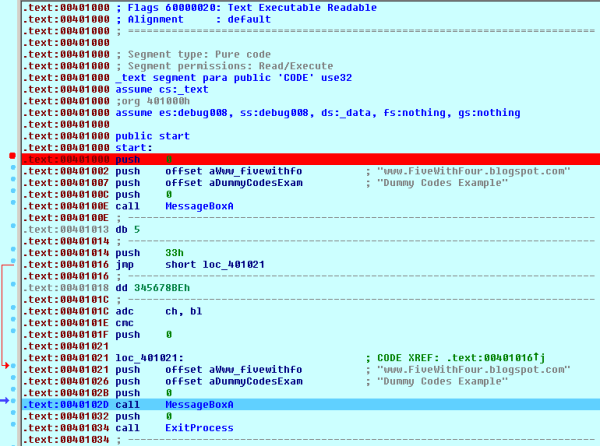.486
.model flat, stdcall
option casemap :none
include \masm32\include\windows.inc
include \masm32\include\kernel32.inc
include \masm32\include\user32.inc
includelib \masm32\lib\user32.lib
includelib \masm32\lib\kernel32.lib
.data
MsgCaption db "www.FiveWithFour.blogspot.com",0
MsgBoxText db "Dummy Codes Example",0
.code
start:
invoke MessageBox, NULL, addr MsgBoxText, addr MsgCaption, MB_OK
@Code:
add eax, 009Eb336Ah
mov esi, 012345678h
jmp @Code+1
invoke MessageBox, NULL, addr MsgBoxText, addr MsgCaption, MB_OK
invoke ExitProcess, NULL
end start
While reading the source we can conclude that the program will throw - one after another - two identical windows of the MB_OK type, containing information. But the result is as follows:
The first window is MB_OK (called within code), but the second one with the same call is a combination of MB_ICONWARNING and MB_YESNOCANCEL - despite the lack of appropriate parameters in the source. The code has been executed in a different way and in order to see how, one should use a disassembler, like OllyDbg which did not cope very well with decompiling, and the debugger leaves much to be desired - at least in terms of the "factory" settings. IDA 6.3 Demo correctly translated the binary code into the assembly code, and the debugger detected the modification of the code during execution. I used a standard build.bat of MASM32 - for those who would like to check out how it actually works. The conclusion is that the free IDA (truncated functions) coped better with an atypical code than OllyDbg. You can find the screenshots of IDA below - the first one relates to a disassembled file - correct according to source, and the second one refers to instructions actually executed by the processor - mov esi, 012345678h in the source it is an additional code - all to deceive the enemy ;-)
Before the code execution:
After the code execution:
The second screenshot is clearly illegible even in IDA. Such a method of code protection against analysis can be a hindrance but also provokes the analysts. The code looks destructive and meaningless, but will not be executed - this is why the dummy codes may be deceitful, but they are not hard to master - their appearance may be the evidence of hidden capabilities of the procedures. It is much harder to analyze even a simple code written in an appropriate high-level language and compiled by one of the all-in-one compilers. Thought experiment with Schrödinger's cat is the simplest way to illustrate this trick ;-)




Brak komentarzy:
Prześlij komentarz